
Agra Travel guide – 4-day Itinerary on best Places to Visit
What would you call a city that has preserved its fascinating history through the reigns of several kingdoms and governments, a city that has its reference in the pages of epic Mahabharata? A place that is home to some of the most iconic monuments and has never failed to capture the imaginations of tourists from around the world. A city that will tickle your taste buds with its culinary richness and leave you with a foodgasm. What else would you call it other than ‘AGRA’ – a land that is known for architectural brilliance, rich heritage, culinary delights, and boasts as ‘City of the Taj’.
Located just 220 km away from the capital Delhi, Agra is the hub to witness the artistic finesse and grandeur of the Mughal era. The amalgamation of Indian, Islamic, Turkish, Persian elements and symmetric patterns in the structures is what makes Mughal constructions wonders of their kind. With several magnificent mosques, tombs, and palaces, Agra has pinned itself in the limelight of the world tourism map. Often explored as part of the famed Golden Triangle loop (along with Delhi and Jaipur), Agra tops as one of the must-see destinations in India. If you are covering it as part of the Golden triangle tour, you might be having only a day to explore. But after visiting this amazing city our suggestion is to take some more time to take pleasure in the sights beyond Taj Mahal and Agra Fort. Over the past decades, Agra has become synonymous with the grand mausoleum ‘Taj Mahal’ and attracts major tourists, but the city has a lot more to offer to those who are willing to stick around for longer than a day.
So here is our guide on what you could do in 3 to 4 days without having any dull moments in this vibrant, lively city.
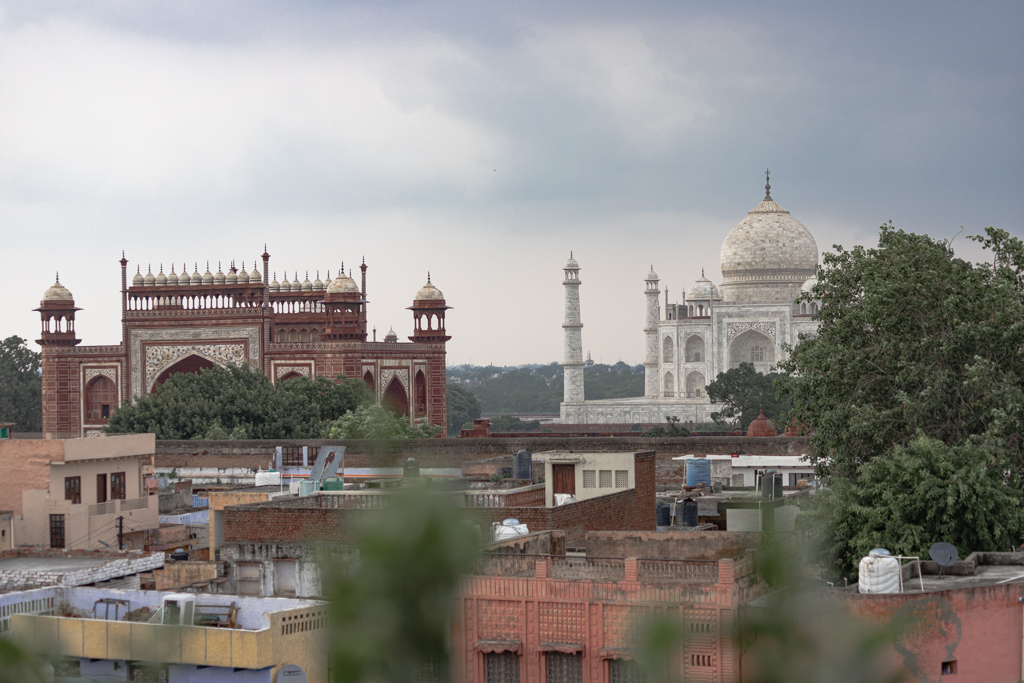
Day 1- Arrive at Agra and check-in:
Most tourists usually get to Agra from Delhi/Jaipur via train or travel agency-operated buses. A few of the Indian cities (Bengaluru, Mumbai, Jaipur, Lucknow, Delhi, Varanasi, and Bhopal) are also directly connected to Agra through non-stop flights. From other cities/countries your best bet is to connect to Delhi and then to reach Agra via train/bus/cabs. We visited Agra during August 2021 just when lockdown restrictions were lifted after several weeks due to the Covid pandemic. We arrived in Agra on a Sunday afternoon which happened to be during the weekend lockdown (though at the timing of writing this blog, lockdowns have been completely lifted). All shops and attractions were closed. So, Day 1 was just about relaxing and scouting areas nearby the Taj Mahal.
Where to stay in Agra:
We booked hotel Atulyaa Taj which was adjacent to Taj East gate, to be precise just 700 meters away. The property is quite up to snuff for the budget accommodation and facilities it offers in a prime location such as Taj East gate road. Although interiors are just average, with a Taj view terrace, rooftop pool, complimentary breakfast, and proximity to the Taj it was perfect for what we were looking for. We highly recommend staying somewhere on the east gate road which offers rooms to fit every budget from hostels and homestays to guesthouses, lodges/bed and breakfasts to 5-star hotels.
A few highly reviewed accommodations that we could list down around this area are Joey’s hostel, Moustache Agra, Atulyaa Taj, The Coral tree homestay, Pearl of Taj, The Retreat, Taj hotel, and convention centre, Trident hotel, The Oberoi Amar Vilas, etc.
Some more places around Agra where you can stay are Howard Plaza-The Fern, Grand Imperial Hotel, ITC Mughal.
After checking in, we took a stroll to look at our surroundings. We walked into one of the well-known rooftop restaurants for a quick bite, but mainly to have a glimpse of the Taj Mahal. Joey’s hostel and Sania Palace restaurant are some of the most sought-after places and each has its unique view of the Taj Mahal to offer.
 Note- Food there is below average and the road leading to both these places are through narrow residential lanes, but the view you get compensates for everything else. While Joey’s seemed super crowded, hotel Saniya palace on the other hand had no other souls than us.
Note- Food there is below average and the road leading to both these places are through narrow residential lanes, but the view you get compensates for everything else. While Joey’s seemed super crowded, hotel Saniya palace on the other hand had no other souls than us.
With every other market, museum, emporiums being closed we spent the evening sipping coffee at our hotel’s terrace restaurant.
Day 2- ‘Wonder of the World’ – Taj Mahal and ‘red sandstone stronghold of the Mughal era’ – Agra Fort
We woke up at 4:30 AM to get ready and visit the greatest wonder of the world. At 5:45, we left our hotel and started walking toward the eastern entry gate. The road from our hotel leading to the entry gate was scenic. The grey sky waiting for the sun to rise, the chirpy birds singing in the nearby forest reserves, the tall trees lining the pathway slowly lighting up, the cool breeze from the surroundings, and the early risers going about their business gave a sense of tranquility.

Entry to Taj Mahal: Taj Mahal has three main entrances. The eastern gate faces towards the Taj Nature walk side and was built in the memory of Emperor Shah Jahan’s other wife Sirhindi Begum; thus, it was named ‘Sirhi Darwaza’ (also referred to as Fatehabadi Darwaza). This gate seems comparatively less crowded than the main entrance on the west side called ‘Fatehpuri Darwaza’ dedicated to another wife Fatehpuri Mahal. While the third entrance The South Gate or ‘Sidhi Darwaza’ faces towards the (old Mumtazabad) present Taj Ganj, a market that has existed since the inception of the monument itself. This gate is perfectly aligned in symmetry to the Great Gate as well as to the Taj Mahal. At present, the gate is closed for Entry and is meant for the pedestrians to exit. There is a red stone Tomb on the right side of this gate which is believed to be a grave of the maid of Mumtaz Mahal. Due to this reason this it is called the ‘Tomb of a Maid of Honour’.
Note: Although before the pandemic there were manual ticket booking counters available near the gates, at present only online ticketing is available, which can be booked from the ASI website in advance (https://asi.payumoney.com/)
Check the ticket prices from the official link (http://www.tajmahal.gov.in/ticketing.aspx)
We scanned out e-tickets from our phones. After a quick frisk through security, we were allowed to walk toward the forecourt of the Taj complex (Jilaukhana). This part of the complex used to serve as a gathering point for the visitors.
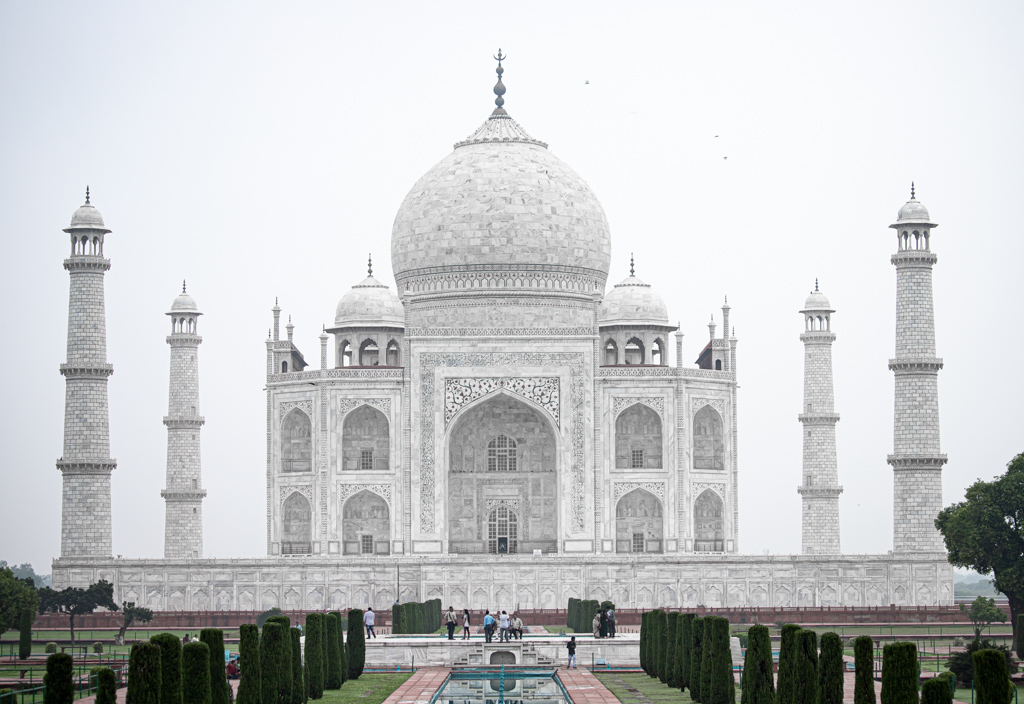
Taj Mahal:
A few steps ahead from the east gate and the first thing we saw was the massive red sandstone entrance known as the Great gate or ‘Darwaza-i-Rauza’. This gate itself is a piece of art that separates the mausoleum and garden from the forecourt. With two ornamented doors on each side (one towards the courtyard and the other towards the Taj) and prolific inlay work of white marble and precious stones, this gate will give you a glimpse of what is in store ahead. This grand entrance is believed to be the gateway to the gardens (Charbagh) which, symbolically, represents Paradise. The 22 domes on top of the rectangular entry building (11 on each side between two high columns) represent the number of years it took for the construction of the Taj Mahal to complete.

We couldn’t help but get on setting up our camera for some pictures. Some of the aged men sitting on the stairs took us through the dos and don’ts in the complex, mainly don’ts. We politely nodded our heads and walked on. As our eyes fell on the gigantic marvel, we were hypnotized, there was love and wonder in the air. Sourab was seeing the Taj for the second time but was astonished as if it was his first time witnessing the wonder. However, we had to stop wondering and move ahead as the crowd slowly started building up. There was a queue of tourists taking photographs and guides advising them on poses, all while talking about the history of the place. We quickly clicked a few frames and moved ahead.
The inner/main complex of the Taj mahal mainly consists of Charbagh (the ornamental gardens divided into four parts, dissected by 4 water bodies with an ornamental marble plinth running through its center). When the first rays of the Sun hit this water body and reflect the image of the main mausoleum it appears to be other-worldly.
At the end of the gardens towards the North, on the bank of the Yamuna there stood the magnificent marvel ‘The Taj Mahal, on a high marble plinth. At the corners of the plinth stand minarets: the four large towers. On the northernmost side, you can see the ‘Chameli Farsh’ the riverfront terrace. This elevated terrace supports the mosque (to the west), the guest pavilion or Mihman Khana or Jawab (to the east), and the main mausoleum (in the center). The mosque and the guest pavilion are the two identical red sandstone buildings on both sides of the mausoleum. While Mosque is an integral part of the complex the guest house was done on the east side considering symmetry.
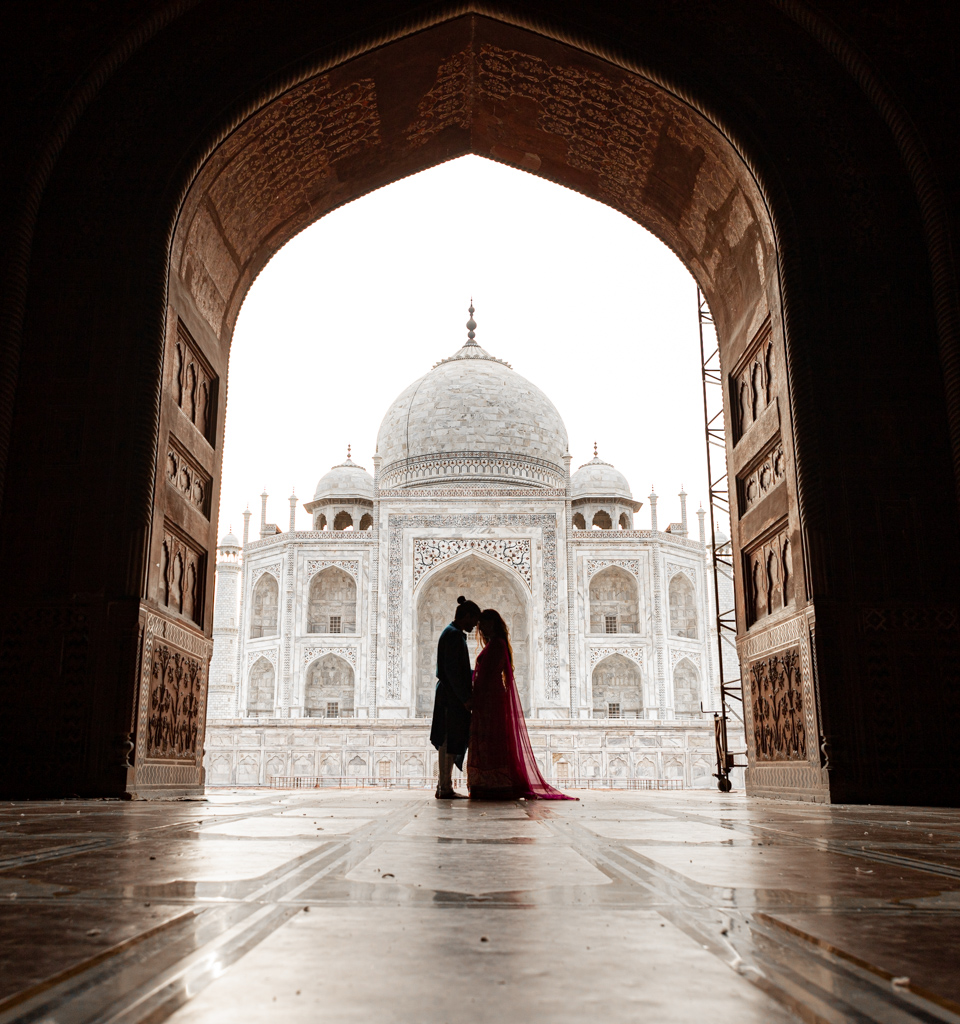
At the center stood the “Crown of all palaces”, a symbol of a husband’s eternal love for his bereaved wife. Built-in semi-translucent white marble this octagonal tomb is a perfect example of symmetrical structure. The intricate carvings and floral motifs of precious and semi-precious gems, the calligraphy works, the symbolic cenotaphs of the Mumtaz Mahal and Emperor Shah Jahan make you realize why it is considered the first wonder of the world.
We walked through the mosque, the seating area, and the mausoleum gazing through every wall, every pillar, and every art. We luckily found an amazing guide who transported us back to history with his superb storytelling. After listening intently through every word of every sentence of what he had to say, we were left wowed. The more we gazed upon the white beauty the more captivated we were. We bid our temporary goodbyes and left the complex at around 10 AM. We took the golf cart service straight to our hotel. After a quick breakfast, we made our way to the next destination
Opening hours: 30 Minutes before sunrise and closes 30 Minutes before sunset during normal operating days. Closed on Fridays for general viewing.
Ticket Price- Indian Visitors- INR 50 per person (200 additional for the mausoleum) / Foreign Visitors- INR 1100 (200 additional for the mausoleum)
Agra Fort:
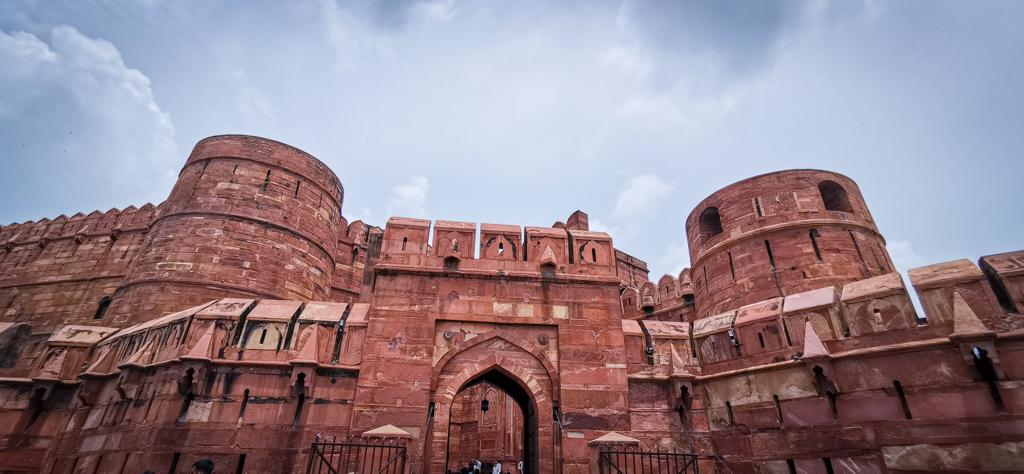 Aside from the Taj, Agra’s other impressive structure is this red sandstone fortress, Agra Fort. It is around 3 km from the Taj mahal. We reached there by 11:30 and the sun was slowly getting above us. Once again, we scanned our e-tickets at the Amar Singh Gate and were let in after a thorough security check. Our Guide from Taj Mahal offered to take us through Agra fort and we started conversing in detail.
Aside from the Taj, Agra’s other impressive structure is this red sandstone fortress, Agra Fort. It is around 3 km from the Taj mahal. We reached there by 11:30 and the sun was slowly getting above us. Once again, we scanned our e-tickets at the Amar Singh Gate and were let in after a thorough security check. Our Guide from Taj Mahal offered to take us through Agra fort and we started conversing in detail.

 Agra Fort is a UNESCO World Heritage site and used to be the residence of the emperors of the Mughal Dynasty. The fort was commissioned by Akbar in 1565 and reportedly took eight years to construct. Most of the fort is currently occupied by the Indian Military, and the rest has a lot to offer to the tourists. Walk through the Diwan-e-Am (Hall of Public Audience) where the emperor would listen to public petitions and meet state officials, Diwan-e-Khas (Hall of private Audience) that was used for receiving distinguished visitors and was adorned by the famous Peacock Throne. Enjoy the beauty of the Anguri Bagh (Courtyard), Sheesh Mahal (Palace of Mirrors), and the gallery from where the Taj Mahal can be viewed. Some other major attractions within the fort walls are the Jahāngīr’s Palace (Jahāngīri Mahal), Bathtub of Jehangir, The Pearl Mosque (Moti Masjid), Khas Mahal. At the end of our visit, we were blessed with some rain showers which made it even more mystical than it already was. It takes 2-3 hours to cover the entire fort.
Agra Fort is a UNESCO World Heritage site and used to be the residence of the emperors of the Mughal Dynasty. The fort was commissioned by Akbar in 1565 and reportedly took eight years to construct. Most of the fort is currently occupied by the Indian Military, and the rest has a lot to offer to the tourists. Walk through the Diwan-e-Am (Hall of Public Audience) where the emperor would listen to public petitions and meet state officials, Diwan-e-Khas (Hall of private Audience) that was used for receiving distinguished visitors and was adorned by the famous Peacock Throne. Enjoy the beauty of the Anguri Bagh (Courtyard), Sheesh Mahal (Palace of Mirrors), and the gallery from where the Taj Mahal can be viewed. Some other major attractions within the fort walls are the Jahāngīr’s Palace (Jahāngīri Mahal), Bathtub of Jehangir, The Pearl Mosque (Moti Masjid), Khas Mahal. At the end of our visit, we were blessed with some rain showers which made it even more mystical than it already was. It takes 2-3 hours to cover the entire fort.


Tip– Do take an umbrella as it gets quite sunny during the afternoons.
Opening hours: 6:00 am – 6:00 pm
Ticket Price- Indian Visitors- INR 50 per person / Foreign Visitors- INR 650/-
Booking website- https://asi.payumoney.com/
Lunch at GMB:
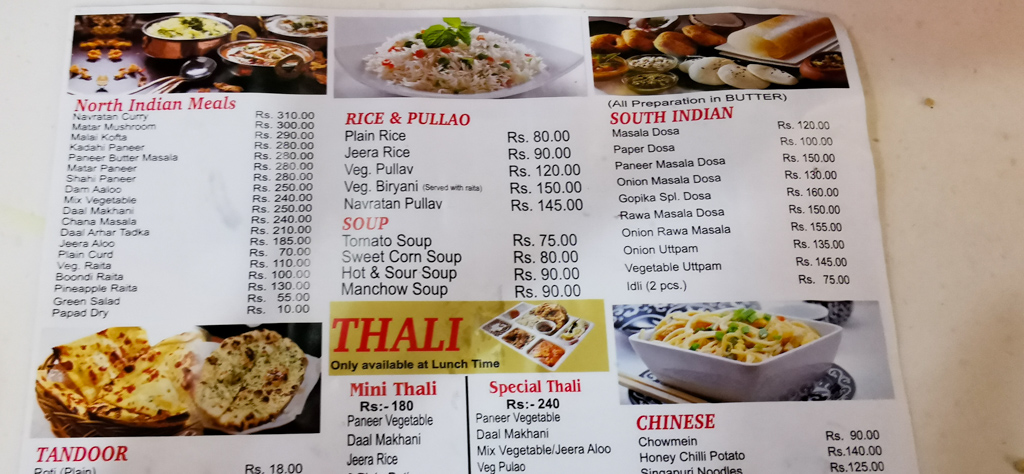 For our lunch, we headed to one of the most popular veg restaurants of Agra – GMB Sweets & Food Plaza on Fatehabad Rd. GMB is a known name in Agra and our guide recommended us this place. Although the eatery looked average, we loved this place for its authentic delicious food and affordable price. Some of the must-try foods are the Thalis, Chole Bhature, Dosa, Chaap, Kesar Jalebi, and kulfi falooda.
For our lunch, we headed to one of the most popular veg restaurants of Agra – GMB Sweets & Food Plaza on Fatehabad Rd. GMB is a known name in Agra and our guide recommended us this place. Although the eatery looked average, we loved this place for its authentic delicious food and affordable price. Some of the must-try foods are the Thalis, Chole Bhature, Dosa, Chaap, Kesar Jalebi, and kulfi falooda.
Exploring Agra’s Street food culture:
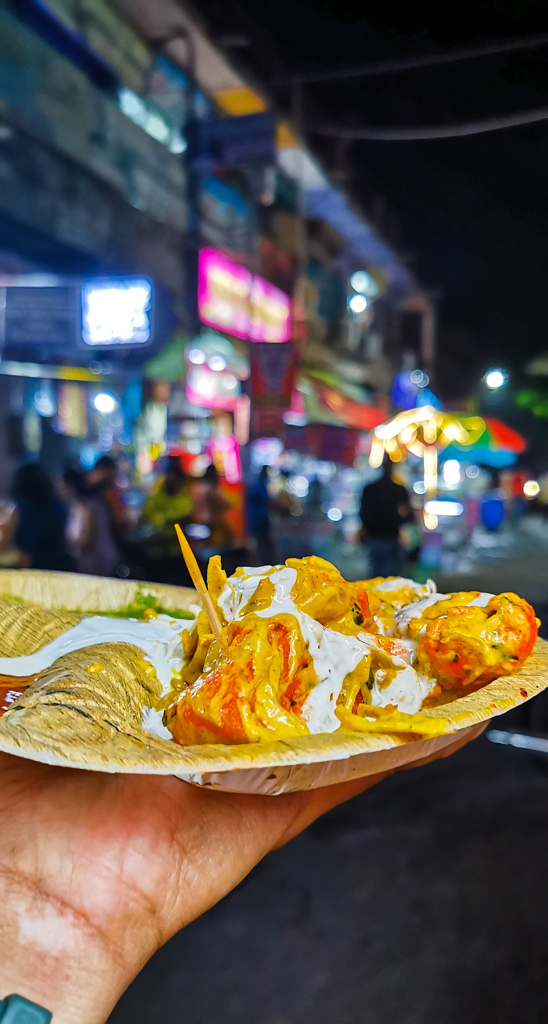 In the evening we spent a few hours savoring the mouth-watering street foods in the Chaat Gali of Agra’s Sadar Bazaar area. Although some of the food shops are open since the morning best time is to visit here after sundown. From all types of Chaats to Momos, Pizzas to Tikkas, soya chaaps, pasta, Pani Puris, rabri, kulfi this alley has a lot to offer to all the foodies. Some of the best shops here are the Agra Chat House, Turban Masterchef Street Food, Pandit Ji Chaat Bhandar, Kishan Kulfi house, etc. A few of our favorites here are Achari and Malai Chaap, Aloo Tikki, Dahi Bhalla, 6 Gol Gappas with different flavors, Mango Kulfi. Also, nearby Sadar Bazaar market you can try another amazing eatery Mama Franky House for its variety of rolls, momo, and chicken gravy.
In the evening we spent a few hours savoring the mouth-watering street foods in the Chaat Gali of Agra’s Sadar Bazaar area. Although some of the food shops are open since the morning best time is to visit here after sundown. From all types of Chaats to Momos, Pizzas to Tikkas, soya chaaps, pasta, Pani Puris, rabri, kulfi this alley has a lot to offer to all the foodies. Some of the best shops here are the Agra Chat House, Turban Masterchef Street Food, Pandit Ji Chaat Bhandar, Kishan Kulfi house, etc. A few of our favorites here are Achari and Malai Chaap, Aloo Tikki, Dahi Bhalla, 6 Gol Gappas with different flavors, Mango Kulfi. Also, nearby Sadar Bazaar market you can try another amazing eatery Mama Franky House for its variety of rolls, momo, and chicken gravy.




Day 3: Fatehpur Sikri- City of Victory
We woke up early to make it to the secret spot to view the Taj Mahal as well as a boat ride on the Yamuna. Unfortunately, the boat ride did not happen due to monsoons and the river being flooded. However, we did get to the secret place and were blessed with some beautiful captures. Check our other blog to know more about this place, link below.
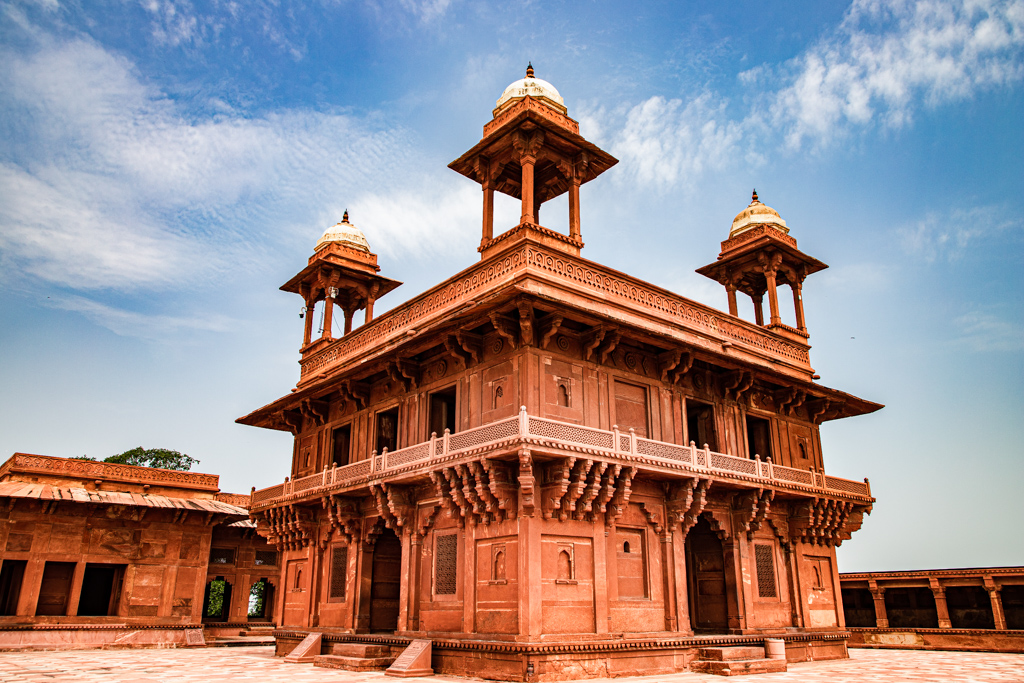 After a quick breakfast and change of clothes, we headed over to the famed Fatehpur Sikri. It was founded by Emperor Akbar and served as the capital from 1571 to 1585. Located around 37 km from Agra this fortified city short-lived as the capital of the Mughal Dynasty and was abandoned due to a shortage of water. Once you arrive there, you need to take a short bus ride to the main entrance. Do hire a guide as the area is vast and difficult to navigate without one, also to know the history of the place and understand the ornate architecture. This deserted city has retained many of the old structures, because of the efforts of the Archaeological department. Top sights are Fatehpur Sikri Fort, Diwan-I-Am (Hall of Public Audience), Diwan-khana-I-Khas (Hall of Private Audience), Panch Mahal (Five level Palace), Turkish Sultana’s House, Ankh Michauli or the Treasury, Daulat khana-I-Khas (Emperor Akbar’s private chamber), Palace of Jodha Bai, the famous Buland Darwaza (the highest and grandest gateway in India that was erected as to commemorate Akbar’s victory over Deccan), Tomb of Sufi saint Salim Chishti and many more. It would take around 3-4 hours to cover the entire place.
After a quick breakfast and change of clothes, we headed over to the famed Fatehpur Sikri. It was founded by Emperor Akbar and served as the capital from 1571 to 1585. Located around 37 km from Agra this fortified city short-lived as the capital of the Mughal Dynasty and was abandoned due to a shortage of water. Once you arrive there, you need to take a short bus ride to the main entrance. Do hire a guide as the area is vast and difficult to navigate without one, also to know the history of the place and understand the ornate architecture. This deserted city has retained many of the old structures, because of the efforts of the Archaeological department. Top sights are Fatehpur Sikri Fort, Diwan-I-Am (Hall of Public Audience), Diwan-khana-I-Khas (Hall of Private Audience), Panch Mahal (Five level Palace), Turkish Sultana’s House, Ankh Michauli or the Treasury, Daulat khana-I-Khas (Emperor Akbar’s private chamber), Palace of Jodha Bai, the famous Buland Darwaza (the highest and grandest gateway in India that was erected as to commemorate Akbar’s victory over Deccan), Tomb of Sufi saint Salim Chishti and many more. It would take around 3-4 hours to cover the entire place.


Tips: Try to avoid unauthorized guides who might pose as genuine. Qualified guides are available near the ticket counter. There is no standard price for the guides so fix up the rate and itinerary upfront before you hire one. We were absolutely amazed getting to hear wonderful stories from our guide Maan Singh who also entertained us with his pun and banter from time to time. We said our goodbyes and headed back to Agra.
Opening hours: Sunrise to Sunset
Ticket Price- Indian Visitors- INR 35 per person / Foreign Visitors- INR 550
Booking website- https://asi.payumoney.com/
Lunch at Pinch of Spice:
 Our guide spoke a lot about this fine dining restaurant and we also checked some reviews. This place was regarded as one of the best restaurants in terms of taste in Agra. We ended up for our lunch here. Must say we were impressed with their quick service and the atmosphere, seemed a pleasant restaurant with a small bar counter as well. The food was utterly delicious, aromatic, and soul-pleasing. Every dish we ordered was irresistible. They offer Indian, Mughlai, Chinese, and some Italian cuisine. If you happen to visit Fatehabad Road then do check out this place.
Our guide spoke a lot about this fine dining restaurant and we also checked some reviews. This place was regarded as one of the best restaurants in terms of taste in Agra. We ended up for our lunch here. Must say we were impressed with their quick service and the atmosphere, seemed a pleasant restaurant with a small bar counter as well. The food was utterly delicious, aromatic, and soul-pleasing. Every dish we ordered was irresistible. They offer Indian, Mughlai, Chinese, and some Italian cuisine. If you happen to visit Fatehabad Road then do check out this place.
Mehtab Bagh:
 How would you feel to roam through a vast garden, next to a river at the time of sunset? Pretty much amazing for a brisk evening walk, isn’t it? Now imagine the garden filled with lots of ponds, fountains, airy pavilions, flowers, and fruit trees, the path you are walking was once followed by the footsteps of royalty. Wouldn’t that be an experience in itself? And as you just couldn’t get more awestruck there lied ahead of the river the white marble wonder. We reached here by 5 PM. Situated north of the Taj Mahal on the other bank of Yamuna, this garden was originally planned by the first Mughal emperor Babur, long before the Taj Mahal was conceptualized. Although it went into disrepair for a long period was later rebuilt by Shah Jahan. He created a moon-shaped from the floodplain to admire the wonder on moonlit nights (thus the name Mehtab meaning moonlight) from the opposite side of the river. Some historical text suggests that Shah Jahan wanted to build another identical Taj Mahal with Black marble which would be his final resting place. But as he was imprisoned by his son Aurangzeb, this dream never turned into a reality. There is a pond amidst the garden now which some believed to be the foundation of the Black Taj. Post-Mughal period the garden was owned by the kingdom of Amber. By the 1990s the garden had almost turned into ruin due to floods and illegal extraction of building materials. But later ASI intervened and restored the grandeur of the garden by planting many trees as per Mughal horticulture.
How would you feel to roam through a vast garden, next to a river at the time of sunset? Pretty much amazing for a brisk evening walk, isn’t it? Now imagine the garden filled with lots of ponds, fountains, airy pavilions, flowers, and fruit trees, the path you are walking was once followed by the footsteps of royalty. Wouldn’t that be an experience in itself? And as you just couldn’t get more awestruck there lied ahead of the river the white marble wonder. We reached here by 5 PM. Situated north of the Taj Mahal on the other bank of Yamuna, this garden was originally planned by the first Mughal emperor Babur, long before the Taj Mahal was conceptualized. Although it went into disrepair for a long period was later rebuilt by Shah Jahan. He created a moon-shaped from the floodplain to admire the wonder on moonlit nights (thus the name Mehtab meaning moonlight) from the opposite side of the river. Some historical text suggests that Shah Jahan wanted to build another identical Taj Mahal with Black marble which would be his final resting place. But as he was imprisoned by his son Aurangzeb, this dream never turned into a reality. There is a pond amidst the garden now which some believed to be the foundation of the Black Taj. Post-Mughal period the garden was owned by the kingdom of Amber. By the 1990s the garden had almost turned into ruin due to floods and illegal extraction of building materials. But later ASI intervened and restored the grandeur of the garden by planting many trees as per Mughal horticulture.
 Today Mehtab bag is one of the best spots outside the main complex to witness the Taj in its full glory. The best time to visit the place is during the sunset. Also, the crowd is almost nil so you can enjoy the uninterrupted view of the Taj at any time of the day.
Today Mehtab bag is one of the best spots outside the main complex to witness the Taj in its full glory. The best time to visit the place is during the sunset. Also, the crowd is almost nil so you can enjoy the uninterrupted view of the Taj at any time of the day.
Opening hours: Sunrise to Sunset
Ticket Price- Indian Visitors- INR 20 per person / Foreign Visitors- INR 250
Booking website- https://asi.payumoney.com/
Visiting a rooftop restaurants to unwind:
We didn’t have many plans for this evening. Agra has some of the best rooftop restaurants, so decided to go for one such place – The Salt Cafe Kitchen & Bar. The ambiance and the décor were appealing and the staffs were courteous. We got to spend some amazing time here relishing the great food, sipping some refreshing cocktails, and indulging in some romantic conversations over live music. A few other rooftops that were recommended were Molecule Air Bar, Cafe Turquoise Cottage, Hichkee, Unplugged Courtyard all of which are highly reviewed.
Day 4- Taj Mahal 2nd Visit
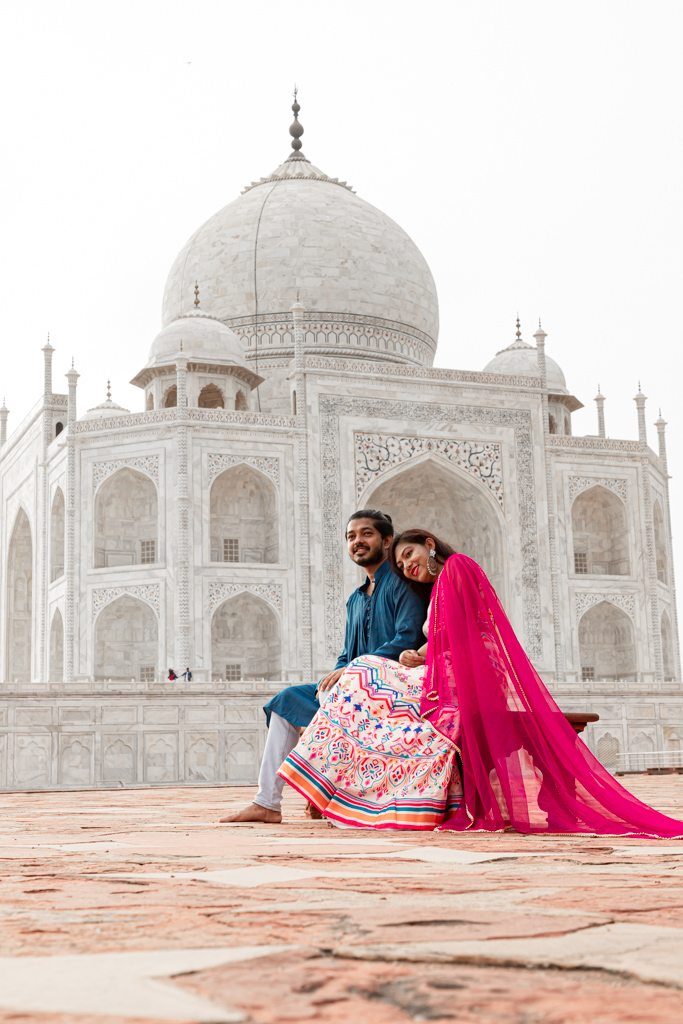 We had kept another day for the Taj Mahal visit for two reasons. 1- Unpredictable weather could ruin our plans or we might miss out on something on the first day. 2- Who doesn’t want a second chance of visiting the Taj right?
We had kept another day for the Taj Mahal visit for two reasons. 1- Unpredictable weather could ruin our plans or we might miss out on something on the first day. 2- Who doesn’t want a second chance of visiting the Taj right?
Rightly so the first day was cloudy and gloomy, not to mention crowded too. A lot of pre-wedding shoots were happening and we hardly got any shots we hoped for. The second visit was a blessing. Clear sky, fewer people and we were free to explore and capture all angles of the Taj. We sat down for a while and absorbed as much as magnificence to serving a lifetime. It was surreal to realize that we are amidst the top wonders of the world.
Itmiad Ud Daulah’s Tomb:
 While the Taj Mahal and Agra Fort grab the attention of major tourists, not far from these two lies another beautiful Mughal creation that very few bother to visit. Often known as the “Baby Taj” or the “jewel box” (due to its resemblance to a jewel box), the Tomb of I’timād-ud-Daulah is a mausoleum that was built under Nur Jahan, (the wife of emperor Jahangir) for her father Mirza Ghiyas Beg and his wife Asmat Beghum’s memory. Mirza Ghiyas Beg was a Persian Amir who served Akbar’s court and was awarded the title of Itimād-ud-Daulah (pillar of the state). He was also the grandfather of Mumtaz-Mahal in whose memory Taj Mahal was built.
While the Taj Mahal and Agra Fort grab the attention of major tourists, not far from these two lies another beautiful Mughal creation that very few bother to visit. Often known as the “Baby Taj” or the “jewel box” (due to its resemblance to a jewel box), the Tomb of I’timād-ud-Daulah is a mausoleum that was built under Nur Jahan, (the wife of emperor Jahangir) for her father Mirza Ghiyas Beg and his wife Asmat Beghum’s memory. Mirza Ghiyas Beg was a Persian Amir who served Akbar’s court and was awarded the title of Itimād-ud-Daulah (pillar of the state). He was also the grandfather of Mumtaz-Mahal in whose memory Taj Mahal was built.
 Positioned at the centre of a Charbagh style garden with the usual enclosing walls and outbuildings, built upon on a red sandstone plinth formed in pure white marble and decorated with fine carvings of semi-precious stones; the architecture has a striking similarity with the Taj. The walls are embellished with intricate designs of semi-precious stones like topaz, onyx and cornelian, jasper, lapis lazuli, onyx, and topaz that are forming artworks imitating vases containing floral bouquets, wine bottles, and cypresses.
Positioned at the centre of a Charbagh style garden with the usual enclosing walls and outbuildings, built upon on a red sandstone plinth formed in pure white marble and decorated with fine carvings of semi-precious stones; the architecture has a striking similarity with the Taj. The walls are embellished with intricate designs of semi-precious stones like topaz, onyx and cornelian, jasper, lapis lazuli, onyx, and topaz that are forming artworks imitating vases containing floral bouquets, wine bottles, and cypresses.
 While the Taj Mahal is considered as the tribute of a husband to his beloved wife, this tomb expresses the affection of a daughter for his bereaved father. Although the monument is protected by the ASI, we were a bit surprised to see that many of its inner walls were in poor condition needing restoration. The site was almost vacant with hardly any visitors.
While the Taj Mahal is considered as the tribute of a husband to his beloved wife, this tomb expresses the affection of a daughter for his bereaved father. Although the monument is protected by the ASI, we were a bit surprised to see that many of its inner walls were in poor condition needing restoration. The site was almost vacant with hardly any visitors.
This fascinating tomb is undoubtedly a heritage that needs to be preserved, maintained, and explored by every traveltravelerute to Agra.
Opening hours: Sunrise to Sunset
Ticket Price- Indian Visitors- INR 20 per person / Foreign Visitors- INR 250
Ticket website- https://asi.payumoney.com/
Akbar’s Tomb:
 Out of all the leaders of the Mughal empire, the Mighty Akbar has etched his name on the pages of history as a liberal, generous, and tolerant ruler. He has relentlessly worked towards the unity of his empire through many campaigns. The grand mausoleum in Sikandra is a marvelous tribute to the great ruler. Constructed between 1605 and 1613, the site for the burial and planning of the tomb was laid down by Akbar himself. While after his death son Jahangir completed the foundation.
Out of all the leaders of the Mughal empire, the Mighty Akbar has etched his name on the pages of history as a liberal, generous, and tolerant ruler. He has relentlessly worked towards the unity of his empire through many campaigns. The grand mausoleum in Sikandra is a marvelous tribute to the great ruler. Constructed between 1605 and 1613, the site for the burial and planning of the tomb was laid down by Akbar himself. While after his death son Jahangir completed the foundation.
 We entered through the South Gate, the largest of the four gates to enter the main tomb complex (although the other gates are only fake getaways). Looking at the red and white sandstone fabricated building, with four minarets we mistook the south gate as the main tomb. But upon crossing it, we were greeted by lush green lawns lined with palm trees. On the other end of the red sandstone walkway stood the huge four-tiered pyramid-shaped structure, surmounted by a marble pavilion where the main tom lies. On the sprawling lawns, we could see various wildlife species from Deer, Antelope, peacocks to Langurs and many birds. The lower floors of the main tomb were made of deep red sandstone mixed with marble whereas, the topmost floor is a pavilion made completely from white marble stone. On the inside panels of the building, you can see calligraphy, floral motifs, and geometrical shapes. In the basement is the actual tomb.
We entered through the South Gate, the largest of the four gates to enter the main tomb complex (although the other gates are only fake getaways). Looking at the red and white sandstone fabricated building, with four minarets we mistook the south gate as the main tomb. But upon crossing it, we were greeted by lush green lawns lined with palm trees. On the other end of the red sandstone walkway stood the huge four-tiered pyramid-shaped structure, surmounted by a marble pavilion where the main tom lies. On the sprawling lawns, we could see various wildlife species from Deer, Antelope, peacocks to Langurs and many birds. The lower floors of the main tomb were made of deep red sandstone mixed with marble whereas, the topmost floor is a pavilion made completely from white marble stone. On the inside panels of the building, you can see calligraphy, floral motifs, and geometrical shapes. In the basement is the actual tomb.
 History says during the rule of Aurangzeb, a revolt from Jats resulted in the ransacking and destroying of the tomb. They looted the precious jewels and carpets, dug out the grave, and burnt the late emperor’s bones. Later during the British era, the Viceroy of India Lord Curzon took care of the extensive repairs and restoration of the mausoleum.
History says during the rule of Aurangzeb, a revolt from Jats resulted in the ransacking and destroying of the tomb. They looted the precious jewels and carpets, dug out the grave, and burnt the late emperor’s bones. Later during the British era, the Viceroy of India Lord Curzon took care of the extensive repairs and restoration of the mausoleum.
Situated on the outskirts of Agra in Mathura National Highway Road, the tomb of the Great Akbar is open from 6 in the morning to 6:30 in the evening on all days except Friday. The ticket costs 20 for Indian visitors and 250 for foreign tourists.
Chini-Ka-Rauza:
 It is the tomb of Afzal Khan Shirazi, a scholar, and poet who was the Prime Minister in the court of Mughal Emperor Shah Jahan. This Indo-Persian architecture was constructed amid a garden set up using ‘chini mitti’ (Chinese clay) and was once renowned for its blue glazed tile work. It has beautiful intricate artwork on the façade. This place is highlighted as one of the attractions to visit when in Agra. We saw some of the intriguing images of its inner enclosure on the internet and thought of exploring it. But was highly disappointed to see such a historical monument on the brink of turning into a ruin. The damage done by the climatic conditions and by the locals living nearby, lack of any administration or restoration from authorities, has left the tomb in an extremely deteriorating state. We could only see a few local boys roaming there and the whole place was stinking with bat guano. This place is closer to Itmad Ud Daula Tomb, however, the lane leading to the site is narrow. Our autorickshaw somehow went till the entry.
It is the tomb of Afzal Khan Shirazi, a scholar, and poet who was the Prime Minister in the court of Mughal Emperor Shah Jahan. This Indo-Persian architecture was constructed amid a garden set up using ‘chini mitti’ (Chinese clay) and was once renowned for its blue glazed tile work. It has beautiful intricate artwork on the façade. This place is highlighted as one of the attractions to visit when in Agra. We saw some of the intriguing images of its inner enclosure on the internet and thought of exploring it. But was highly disappointed to see such a historical monument on the brink of turning into a ruin. The damage done by the climatic conditions and by the locals living nearby, lack of any administration or restoration from authorities, has left the tomb in an extremely deteriorating state. We could only see a few local boys roaming there and the whole place was stinking with bat guano. This place is closer to Itmad Ud Daula Tomb, however, the lane leading to the site is narrow. Our autorickshaw somehow went till the entry.
Once upon a time, this architecture might have astonished many onlookers but today it is not what it used to be centuries ago.
The monument is open from sunrise to sunset and there is no entry fee.
Sheroes Hangout:
This place was one of the major places that we wanted to visit for lunch while in Agra. Sheroes Hangout is a cafe and community in India opened by an NGO, is a symbol of bravery, empowerment, and the fight against social stigma. Run by survivors of acid attacks this café has a modest menu of snacks, Indian bread, gravies, and Chinese dishes. Earlier they offered a ‘pay what you want’ model for the menu. But in recent years it was set to a fixed menu with a fixed prices model. The café aims to increase awareness about the brutality of acid attacks and forbid this act of violence. It has not only offered employment to its survivors but has given them the confidence to face society without any regret and earn a respectful living.
Unfortunately, the cafe was closed for a few days when we visited and couldn’t get a chance to meet these warriors/sheroes.
At our driver’s recommendation, we ate our lunch at a local restaurant named Taste of India in Tajganj. We opted for a combo meal. The ambiance was average but the food was tasty and also very filling.
Day 5- Soaking in the Sun and Chilling in the pool in a Vintage hotel
 We stayed for an additional day just to relax after having some packed days. We stayed at the historic Grand Imperial Hotel. The day was all about having delicious in-room breakfast, drinks by the pool, and hours of conversations.
We stayed for an additional day just to relax after having some packed days. We stayed at the historic Grand Imperial Hotel. The day was all about having delicious in-room breakfast, drinks by the pool, and hours of conversations.
 Our trip to Agra was delightful, we met some amazing people who touched our hearts, learned a lot about the history (Wish we had done that before to have scored good marks in school) and we came back with great memories.
Our trip to Agra was delightful, we met some amazing people who touched our hearts, learned a lot about the history (Wish we had done that before to have scored good marks in school) and we came back with great memories.
BeyondSAS
Sourab and Gloriya are travel bloggers who love to explore the world and share their experiences with their audience. They write in-depth travel guides, tips and hacks to help you plan your trips better and save money. Whether you are looking for the best places to visit, the best time to go, or the best way to travel, they have you covered. Follow their blog and discover new destinations, cultures and adventures.
You May Also Like

Copenhagen in a day
November 10, 2019
5 best places to take exceptional photographs of the Taj Mahal
January 25, 2022
 Facebook
Facebook
